Answered step by step
Verified Expert Solution
Question
1 Approved Answer
The pandemic has caused the massive growth of public debt in many countries. With reference to the latest supply bill based on the research attached
The pandemic has caused the massive growth of public debt in many countries. With reference to the latest supply bill based on the research attached below devolpe four research questions 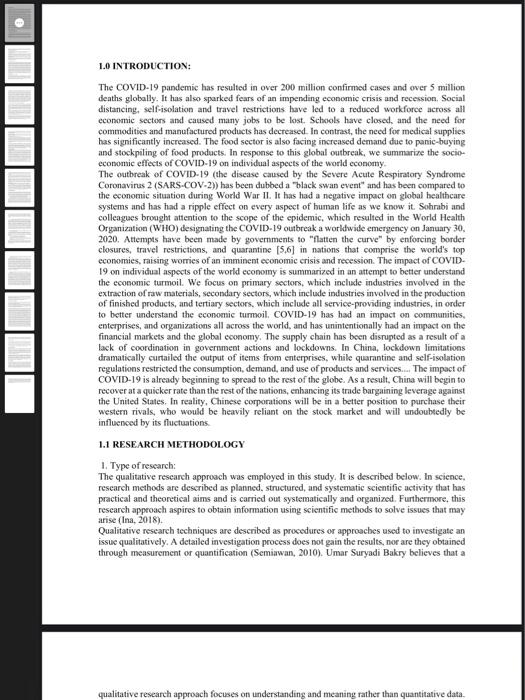

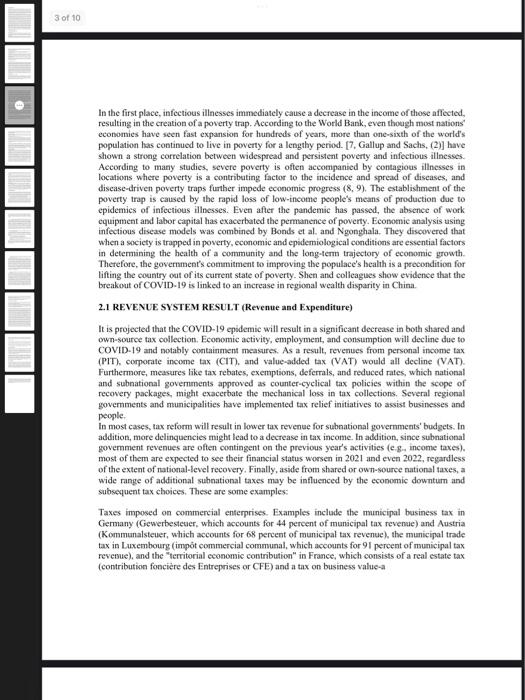

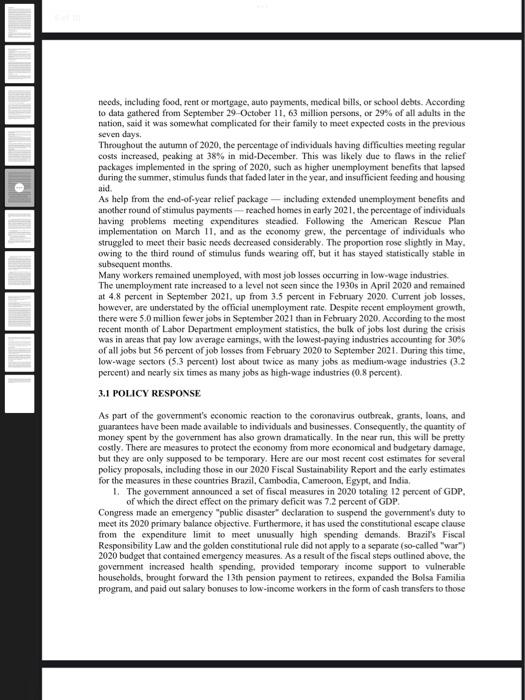
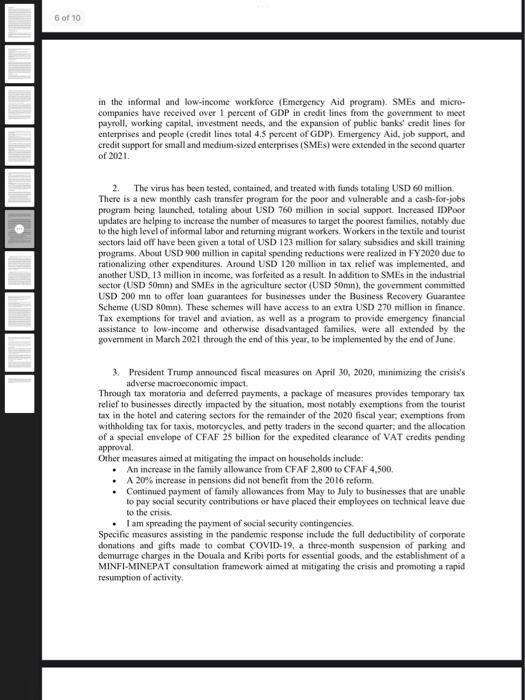
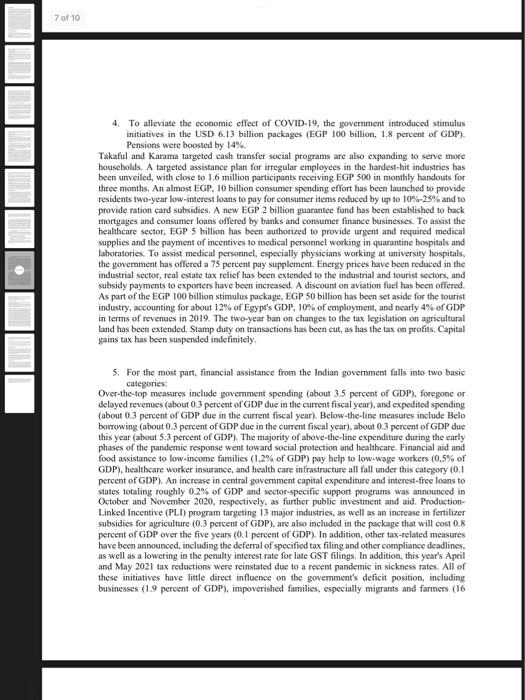
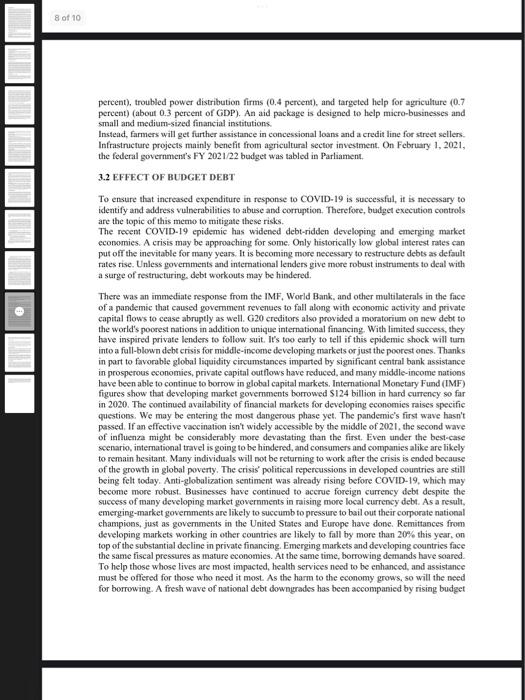
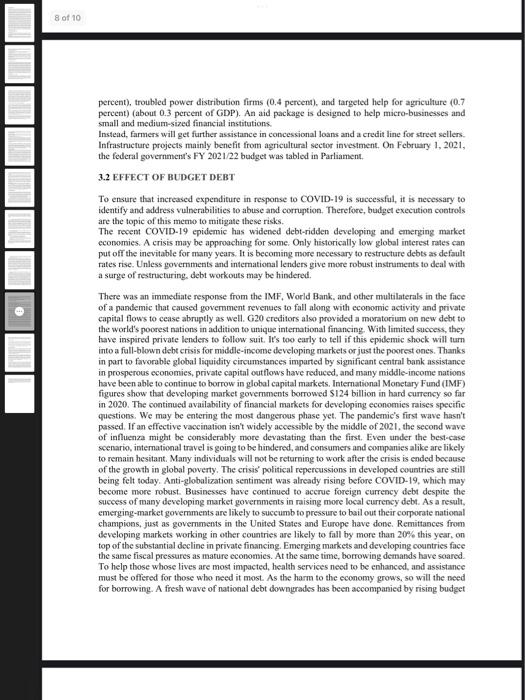
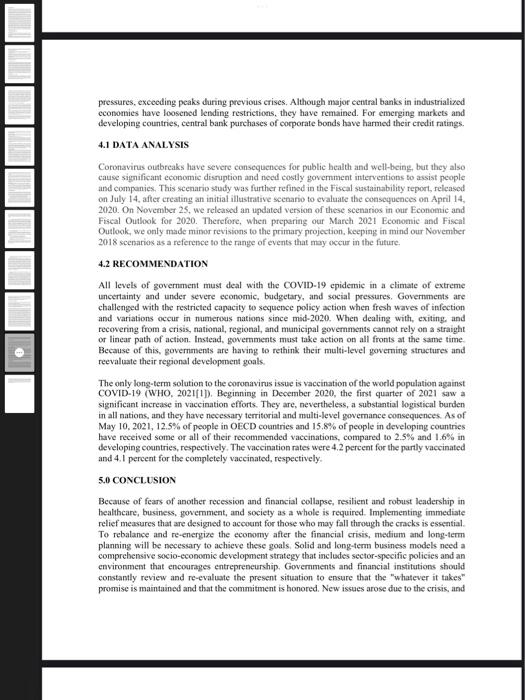
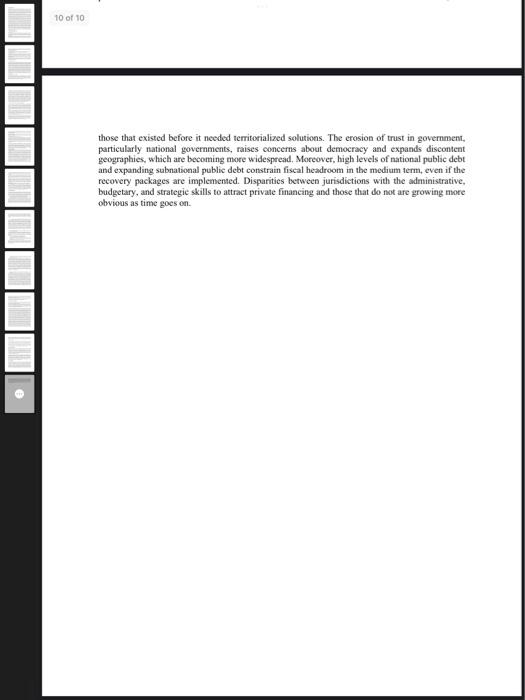
LO INTRODUCTION: The COVID-19 pandemic has resulted in over 200 million confirmed cases and over 5 million deaths globally. It has also sparked fears of an impending economic crisis and recession. Social distancing, self-isolation and travel restrictions have led to a reduced workforce across all economic sectors and caused many jobs to be lost. Schools have closed, and the need for commodities and manufactured products has decreased. In contrast, the need for medical supplies has significantly increased. The food sector is also facing increased demand due to panic-buying and stockpiling of food products. In response to this global outbreak, we summarize the socio- economic effects of COVID-19 on individual aspects of the world economy The outbreak of COVID-19 (the discase caused by the Severe Acute Respiratory Syndrome Coronavirus 2 (SARS-COV-2)) has been dubbed a "black swan event and has been compared to the economic situation during World War 11. It has had a negative impact on global healthcare systems and has had a ripple effect on every aspect of human life as we know it. Sohrabi and colleagues brought attention to the scope of the epidemic, which resulted in the World Health Organization (WHO) designating the COVID-19 outbreak a worldwide emergency on January 30, 2020. Attempts have been made by governments to "flatten the curve" by enforcing border closures, travel restrictions, and quarantine (5.6) in nations that comprise the world's top economies, raising worries of an imminent economic crisis and recession. The impact of COVID- 19 on individual aspects of the world economy is summarized in an attempt to better understand the economic turmoil. We focus on primary sectors, which include industries involved in the extraction of raw materials, secondary sectors, which include industries involved in the production of finished products, and tertiary sectors, which include all service providing industries, in order to better understand the economic turmoil. COVID-19 has had an impact on communities. enterprises, and organizations all across the world, and has unintentionally had an impact on the financial markets and the global economy. The supply chain has been disrupted as a result of a lack of coordination in government actions and lockdowns. In China, lockdown limitations dramatically curtailed the output of items from enterprises, while quarantine and self-isolation regulations restricted the consumption, demand, and use of products and services.... The impact of COVID-19 is already beginning to spread to the rest of the globe. As a result, China will begin to recover at a quicker rate than the rest of the nations, enhancing its trade bargaining leverage against the United States. In reality, Chinese corporations will be in a better position to purchase their Western rivals, who would be heavily reliant on the stock market and will undoubtedly be influenced by its fluctuations 1.1 RESEARCH METHODOLOGY 1. Type of research: The qualitative research approach was employed in this study. It is described below. In science, research methods are described as planned, structured, and systematic scientific activity that has practical and theoretical aims and is carried out systematically and organized. Furthermore, this research approach aspires to obtain information using scientific methods to solve issues that may arise (Ina, 2018). Qualitative research techniques are described as procedures or approaches used to investigate an issue qualitatively. A detailed investigation process does not gain the results, nor are they obtained through measurement or quantification (Semiawan, 2010). Umar Suryadi Bakry believes that a qualitative research approach focuses on understanding and meaning rather than quantitative data. 2 of 10 qualitative research approach focuses on understanding and meaning rather than quantitative data. Quality research is also characterized as creating cohesive and efficient analysis methodical and intuitive in its system (Bakry, 2016, p. 62). 2. The topic of the research: The aim of this investigation is that the epidemie has resulted in a significant increase in public debt in some nations, according to the most recent budget plan for the supply bill, 3. Data Collection Tool: Concerning the data source that has to be tracked down, the data source employed in this methodology is the secondary data retrieval method. Secondary research is carried out by conducting searches in scientific papers or articles, joumals, and books relevant to the issues under consideration (Sugiyono, 2006. p.25). Generally speaking, secondary data may be characterized as facts or writings in the form of reports from other people's studies gathered via the use of library and document research For this reason, to gather information for this study, the writer will compile a bibliography and documentation from previous research published in journals, books, and documents from websites, English and Malay online news media, newsletters, and magazines, and reports or briefings from various international organizations 2.0 PANDEMIC GROWTH Infectious illnesses have had a devastating impact on the economics of several low-income nations Gallup and Sachs examine the association between poverty and malaria in tropical and subtropical countries. They discover that the places with severe malaria have been in poverty for an extended period and that this has been accompanied by sluggish economic progress throughout that time According to Holtkamp and colleagues, the economic effect of the swine flu outbreak on the United States economy from 2005 to 2010 was estimated using data on agricultural firms provided by the United States Department of Agriculture. The findings revealed that the outbreak generated an average yearly coonomic loss of around 664 million US dollars annually. According to Joo ct al, there has been a significant negative influence on the total economic development of South Korea. Zhang and colleagues demonstrate that pandemies have unanticipated socioeconomic and long-term consequences in low- and middle-income nations. Individuals and countries with lower socioeconomic status fare poorly in these circumstances. According to Brown and colleagues, the COVID-19 pandemic has had a significant influence on people's lives in the United States. It has expanded to more than 200 nations and all 50 states of the United States in the months after the COVID-19 epidemic was discovered initially. Because of the pandemic's long-term influence on global economic development, it has been around for more than a century. As of now, it is estimated that the virus would slow global economic growth to an annualized pace of between 4.5 and 6.0% in 2020. Pandemic-Induced Poverty: A Catch-22 The infectious illnesses will impair or even eliminate the capacity to work of the affected individual, resulting in a decrease in revenue and labor availability. Because of this, there would be a shortage of investment and other factor input, which would ultimately result in economic development being suppressed. In addition, the effect of infectious illnesses and associated pandemic preventive measures on human capital accumulation would also hinder the increase of production efficiency and the acceleration of coonomic growth. 3 of 10 In the first place, infectious illnesses immediately cause a decrease in the income of those affected. resulting in the creation of a poverty trap. According to the World Bank, even though most nations economies have seen fast expansion for hundreds of years, more than one-sixth of the world's population has continued to live in poverty for a lengthy period. [7. Gallup and Sachs, (2) have shown a strong correlation between widespread and persistent poverty and infectious illnesses. According to many studies, severe poverty is often accompanied by contagious illnesses in locations where poverty is a contributing factor to the incidence and spread of diseases, and disease-driven poverty traps further impede economic progress (8,9). The establishment of the poverty trap is caused by the rapid loss of low-income people's means of production due to epidemics of infectious illnesses. Even after the pandemic has passed, the absence of work equipment and labor capital has exacerbated the permanence of poverty. Economic analysis using infectious disease models was combined by Bonds et al. and Ngonghala. They discovered that when a society is trapped in poverty, economic and epidemiological conditions are essential factors in determining the health of a community and the long-term trajectory of economic growth Therefore, the government's commitment to improving the populace's health is a precondition for lifting the country out of its current state of poverty. Shen and colleagues show evidence that the breakout of COVID-19 is linked to an increase in regional wealth disparity in China. 2.1 REVENUE SYSTEM RESULT (Revenue and Expenditure) It is projected that the COVID-19 epidemic will result in a significant decrease in both shared and own-source tax collection, Economic activity, employment, and consumption will decline due to COVID-19 and notably containment measures. As a result, revenues from personal income tax (PIT), corporate income tax (CIT), and value-added tax (VAT) would all decline (VAT). Furthermore, measures like tax rebates, exemptions, deferrals, and reduced rates, which national and subnational governments approved as counter-cyclical tax policies within the scope of recovery packages, might exacerbate the mechanical loss in tax collections. Several regional governments and municipalities have implemented tax relief initiatives to assist businesses and people in most cases, tax reform will result in lower tax revenue for subnational governments budgets. In addition, more delinquencies might lead to a decrease in tax income. addition, since subnational government revenues are often contingent on the previous year's activities (eg, income taxes). most of them are expected to see their financial status worsen in 2021 and even 2022, regardless of the extent of national-level recovery. Finally, aside from shared or own-source national taxes, a wide range of additional suhnational taxes may be influenced by the economic downturn and subsequent tax choices. These are some examples: Taxes imposed on commercial enterprises. Examples include the municipal business tax in Germany (Gewerbesteuer, which accounts for 44 percent of municipal tax revenue) and Austria (Kommunalsteuer, which accounts for 68 percent of municipal tax revenue), the municipal trade tax in Luxembourg (impt commercial communal, which accounts for 91 percent of municipal tax revenue), and the territorial economic contribution" in France, which consists of a real estate tax (contribution foncire des Entreprises or CFE) and a tax on business value-a 4 of 10 Provincial taxes on productive output (IRAP) in Italy, municipal income taxes in Korea and Japan. and the Japanese resident tax based on individual and corporate income are examples of taxes levied on economic activity Taxes associated with real estate activities, such as real estate transaction taxes, construction permits and rights, and so on. Those levied on consumption by individuals and businesses, such as sales tax, fuel taxes, energy- product taxes, automobile-related taxes, and taxes on leisure, such as tourist taxes, advertising taxes, casino taxes, and so on. We are obtaining tax revenue from commodities sectors. Because they are a less unreliable source of income than capital gains taxes, recurring property taxes on land and buildings should be less influenced. The probability of a drop in property prices on the other hand, is reduced if the property tax is determined based on market value. However, the reduction in property values will be reflected in budgets later (2021 or 2022). Notably, there has also been an increase in some areas as a result of an increase in newcomers who are taking advantage of teleworking opportunities, particularly in peri-urban and rural areas with good transport connections (for example, prices in Auckland have increased by 18 percent since the beginning of the year) Furthermore, as a consequence of corporate bankruptcies, it is expected that income from commercial property taxes would be lower than they were before. Revenues might also be reduced due to tax exemptions and write-offs for certain taxpayers who are experiencing financial difficulties and increasing delinquencies. Subnational governments will have to deal with the consequences of property tax deferrals, Budgets and liquidity in nations where property tax income is the primary source of municipal tax revenue (es. Australia, Canada, Estonia, Ireland Israel Lithuania, the Netherlands, the United States, and the United Kingdom) might be strained if potential delays continue into a new fiscal year (OECD, Forthcoming[62]). 2.2 PUBLIC RESPONSE According to the Household Pulse statistics, millions of people are behind on their rent or mortgage payments. Unfortunately, there are two issues concerning housing. First, beginning with the late- August 2020 poll, the Census Bureau reworded the rent payment question, rendering the data incomparable to prior weeks of the survey. Second, Census lengthened the whole study simultaneously, leading to more respondents skipping items at the conclusion, including the housing questions. This "non-response" is more common among younger groups, have lower levels of education, and identify as Black or Latino - groups who are more likely to struggle to pay the rent owing to long-standing imbalances in education, work, and housing. As a result, the Pulse data is expected to underestimate the number of persons who cannot pay their rent. Despite these challenges, statistics show that millions of people have trouble paying their rent. According to statistics gathered from September 29 to October 11, an estimated 12 million individuals living in a rental property-or 16 percent of adult renters were behind on their rent. Renters of color were also more likely to indicate that their household was behind on payments: 28% of Black renters, 18% of Latino renters, and 20% of Asian renters stated they were behind on charges, compared to just 12% of white renters. For American Indian, Alaska Native, Native Hawaiian Pacific Islander, and multiracial adults combined, the percentage was 18 percent. Having a Hard Time Covering Household Expenses Since late August 2020, the Household Pulse Survey has published information on the number of persons suffering to pay for basic household needs, including food, rent or mortgage, auto payments, medical bills, or school debts. According to data gathered from September 29-October 11, 63 million persons, or 29% of all adults in the nation, said it was somewhat complicated for their family to meet expected costs in the previous seven days. Throughout the autumn of 2020, the percentage of individuals having difficulties meeting regular costs increased, peaking at 38% in mid-December. This was likely due to flaws in the relief packages implemented in the spring of 2020, such as higher unemployment benefits that lapsed during the summer, stimulus funds that faded later in the year, and insufficient feeding and housing aid As help from the end-of-year relief package including extended unemployment benefits and another round of stimulus payments-reached homes in early 2021. the percentage of individuals having problems meeting expenditures steadied. Following the American Rescue Plan implementation on March 11, and as the economy grew, the percentage of individuals who struggled to meet their basic needs decreased considerably. The proportion rose slightly in May. owing to the third round of stimulus funds wearing off, but it has stayed statistically stable in subsequent months. Many workers remained unemployed, with most job losses occurring in low-wage industries The unemployment rate increased to a level not seen since the 1930s in April 2020 and remained at 4.8 percent in September 2021, up from 3.5 percent in February 2020. Current job losses, however, are understated by the official unemployment rate. Despite recent employment growth, there were 5.0 million fewer jobs in September 2021 than in February 2020. According to the most recent month of Labor Department employment statistics, the bulk of jobs lost during the crisis was in areas that pay low average earnings, with the lowest-paying industries accounting for 30% of all jobs but 56 percent of job losses from February 2020 to September 2021. During this time low-wage sectors (5.3 percent) lost about twice as many jobs as medium-wage industries (3.2 percent) and nearly six times as many jobs as high-wage industries (0.8 percent). 3.1 POLICY RESPONSE As part of the government's economic reaction to the coronavirus outbreak, grants, loans, and guarantees have been made available to individuals and businesses. Consequently, the quantity of money spent by the government has also grown dramatically. In the near run, this will be pretty costly. There are measures to protect the economy from more economical and budgetary damage but they are only supposed to be temporary. Here are our most recent cost estimates for several policy proposals, including those in our 2020 Fiscal Sustainability Report and the early estimates for the measures in these countries Brazil, Cambodia Cameroon, Egypt, and India 1. The government announced a set of fiscal measures in 2020 totaling 12 percent of GDP. of which the direct effect on the primary deficit was 7.2 percent of GDP. Congress made an emergency "public disaster declaration to suspend the government's duty to meet its 2020 primary balance objective. Furthermore, it has used the constitutional escape clause from the expenditure limit to meet unusually high spending demands. Brazil's Fiscal Responsibility Law and the golden constitutional rule did not apply to a separate (so-called "war") 2020 budget that contained emergency measures. As a result of the fiscal steps outlined above, the government increased health spending provided temporary income support to vulnerable households, brought forward the 13th pension payment to retirees, expanded the Bolsa Familia program, and paid out salary bonuses to low-income workers in the form of cash transfers to those 6 of 10 in the informal and low-income workforce (Emergency Aid program). SMEs and micro- companies have received over 1 percent of GDP in credit lines from the government to meet payroll, working capital, investment needs, and the expansion of public banks credit lines for enterprises and people (credit lines total 4.5 percent of GDP). Emergency Aid.job support, and credit support for small and medium-sized enterprises (SMEs) were extended in the second quarter of 2021 2. The virus has been tested, contained, and treated with funds totaling USD 60 million There is a new monthly cash transfer program for the poor and vulnerable and a cash-for-jobs program being launched, totaling about USD 760 million in social support. Increased IDPoor updates are helping to increase the number of measures to target the poorest families, notably due to the high level of informal labor and returning migrant wa Workers in the textile and tourist sectors laid off have been given a total of USD 123 million for salary subsidies and skill training programs. About USD 900 million in capital spending reductions were realized in FY 2020 due to rationalizing other expenditures. Around USD 120 million in tax relief was implemented, and another USD. 13 million in income, was forfeited as a result. In addition to SMEs in the industrial sector (USD 50mn) and SMEs in the agriculture sector (USD 50m), the government committed USD 200 mn to offer loan guarantees for businesses under the Business Recovery Guarantee Scheme (USD 80m). These schemes will have access to an extra USD 270 million in finance Tax exemptions for travel and aviation, as well as a program to provide emergency financial assistance to low-income and otherwise disadvantaged families were all extended by the government in March 2021 through the end of this year, to be implemented by the end of June. 3. President Trump announced fiscal measures on April 30, 2020, minimizing the crisis's adverse macroeconomic impact Through tax moratoria and deferred payments, a package of measures provides temporary tax relief to businesses directly impacted by the situation, most notably exemptions from the tourist tax in the hotel and catering sectors for the remainder of the 2020 fiscal year, exemptions from withholding tax for taxis, motorcycles, and petty traders in the second quarter, and the allocation of a special envelope of CFAF 25 billion for the expedited clearance of VAT credits pending approval Other measures aimed at mitigating the impact on households include: An increase in the family allowance from CFAF 2,800 to CFAF 4,500 A 20% increase in pensions did not benefit from the 2016 reform. Continued payment of family allowances from May to July to businesses that are unable to pay social security contributions or have placed their employees on technical leave due to the crisis. I am spreading the payment of social security contingencies Specific measures assisting in the pandemic response include the full deductibility of corporate donations and gifts made to combat COVID-19, a three-month suspension of parking and demurrage charges in the Douala and Kribi ports for essential goods, and the establishment of a MINFI-MINEPAT consultation framework aimed at mitigating the crisis and promoting a rapid resumption of activity 7 of 10 4. To alleviate the economic effect of COVID-19, the government introduced stimulus initiatives in the USD 6.13 billion packages (EGP 100 billion, 1.8 percent of GDP). Pensions were boosted by 14%. Takaful and Karama targeted cash transfer social programs are also expanding to serve more households. A targeted assistance plan for irregular employees in the hardest-hit industries has been unveiled, with close to 1.6 million participants receiving EGP 500 in monthly handouts for three months. An almost EGP, 10 billion consumer spending effort has been launched to provide residents two-year low-interest loans to pay for consumer items reduced by up to 10%-25% and to provide ration card subsidies. A new EGP 2 billion guarantee fund has been established to back mortgages and consumer loans offered by banks and consumer fissance businesses. To assist the healthcare sector, EGP 5 billion been authorized to provide urgent and required medical supplies and the payment of incentives to medical personnel working in quarantine hospitals and laboratories. To assist medical personnel, especially physicians working at university hospitals, the government has offered a 75 percent pay supplement. Energy prices have been reduced in the industrial sector, real estate tax relief has been extended to the industrial and tourist sectors, and subsidy payments to exporters have been increased. A discount on aviation fuel has been offered As part of the EGP 100 billion stimulus package, EGP 50 billion has been set aside for the tourist industry, accounting for about 12% of Egypt's GDP, 10% of employment, and nearly 4% of GDP in terms of revenues in 2019. The two-year ban on changes to the tax legislation on agricultural land has been extended. Stamp duty on transactions has been cut, as has the tax on profits. Capital gains tax has been suspended indefinitely 5. For the most part, financial assistance from the Indian government falls into two basic categories: Over-the-top measures include government spending (about 35 percent of GDP), foregone or delayed revenues (about 0.3 percent of GDP due in the current fiscal year), and expedited spending (about 0.3 percent of GDP due in the current fiscal year). Below-the-line measures include Belo borrowing (about 03 percent of GDP due in the current fiscal year), about 03 percent of GDP due this year (about 5.3 percent of GDP). The majority of above-the-line expenditure during the early phases of the pandemic response went toward social protection and healthcare. Financial aid and food assistance to low-income families (1.2% of GDP) pay help to low-wage workers (0.5% of GDP), healthcare worker insurance, and health care infrastructure all fall under this category (0.1 percent of GDP). An increase in central government capital expenditure and interest-free loans to states totaling roughly 0.2% of GDP and sector-specific support programs was announced in October and November 2020, respectively, as further public investment and aid. Production- Linked Incentive (PLI) program targeting 13 major industries, as well as an increase in fertilizer subsidies for agriculture (0.3 percent of GDP), are also included in the package that will cost 0.8 percent of GDP over the five years (0.1 percent of GDP). In addition, other tax-related measures have been announced, including the deferral of specified tax filing and other compliance deadlines, as well as a lowering in the penalty interest rate for late GST filings. In addition, this year's April and May 2021 tax reductions were reinstated due to a recent pandemic in sickness rates. All of these initiatives have little direct influence on the government's deficit position, including businesses (1.9 percent of GDP), impoverished families, especially migrants and farmers (16 8 of 10 percent), troubled power distribution firms (0.4 percent), and targeted help for agriculture (0.7 percent) (about 0.3 percent of GDP). An aid package is designed to help micro-businesses and small and medium-sized financial institutions Instead, farmers will get further assistance in concessional loans and a credit line for street sellers Infrastructure projects mainly benefit from agricultural sector investment. On February 1, 2021, the federal government's FY 2021/22 budget was tabled in Parliament 3.2 EFFECT OF BUDGET DEBT To ensure that increased expenditure in response to COVID-19 is successful, it is necessary to identify and address vulnerabilities to abuse and corruption. Therefore, budget execution controls are the topic of this memo to mitigate these risks. The recent COVID-19 epidemic has widened debt-ridden developing and emerging market economies. A crisis may be approaching for some. Only historically low global interest rates can put off the inevitable for many years. It is becoming more necessary to restructure debts as default rates rise. Unless governments and international lenders give more robust instruments to deal with a surge of restructuring, debt workouts may be hindered. There was an immediate response from the IMF, World Bank, and other multilaterals in the face of a pandemic that caused government revenues to fall along with economic activity and private capital flows to cease abruptly as well. G20 creditors also provided a moratorium on new debt to the world's poorest nations in addition to unique international financing. With limited success, they have inspired private lenders to follow suit. It's too early to tell if this epidemic shock will turn into a full-blown debt crisis for middle-income developing markets or just the poorest ones. Thanks in part to favorable global liquidity circumstances imparted by significant central bank assistance in prosperous economics, private capital outflows have reduced, and many middle-income nations have been able to continue to borrow in global capital markets. International Monetary Fund (IMF) figures show that developing market govemments borrowed S124 billion in hard currency so far in 2020. The continued availability of financial markets for developing economies raises specific questions. We may be entering the most dangerous phase yet. The pandemic's first wave hasn't passed. If an effective vaccination isn't widely accessible by the middle of 2021, the second wave of influenza might be considerably more devastating than the first. Even under the best-case scenario, international travel is going to be hindered, and consumers and companies alike are likely to remain hesitant. Many individuals will not be returning to work after the crisis is ended because of the growth in global poverty. The crisis political repercussions in developed countries are still being felt today. Anti-globalization sentiment was already rising before COVID-19, which may become more robust. Businesses have continued to accrue foreign currency debt despite the success of many developing market governments in raising more local currency debt. As a result, emerging market goverments are likely to succumb to pressure to bail out their corporate national champions, just as governments in the United States and Europe have done. Remittances from developing markets working in other countries are likely to fall by more than 20% this year, on top of the substantial decline in private financing. Emerging markets and developing countries face the same fiscal pressures as mature economies. At the same time, borrowing demands have scared To help those whose lives are most impacted, health services need to be enhanced, and assistance must be offered for those who need it most. As the harm to the economy grows, so will the need for borrowing. A fresh wave of national debt downgrades has been accompanied by rising budget 8 of 10 percent), troubled power distribution firms (0.4 percent), and targeted help for agriculture (0.7 percent) (about 0.3 percent of GDP). An aid package is designed to help micro-businesses and small and medium-sized financial institutions Instead, farmers will get further assistance in concessional loans and a credit line for street sellers Infrastructure projects mainly benefit from agricultural sector investment. On February 1, 2021, the federal government's FY 2021/22 budget was tabled in Parliament 3.2 EFFECT OF BUDGET DEBT To ensure that increased expenditure in response to COVID-19 is successful, it is necessary to identify and address vulnerabilities to abuse and corruption. Therefore, budget execution controls are the topic of this memo to mitigate these risks. The recent COVID-19 epidemic has widened debt-ridden developing and emerging market economies. A crisis may be approaching for some. Only historically low global interest rates can put off the inevitable for many years. It is becoming more necessary to restructure debts as default rates rise. Unless governments and international lenders give more robust instruments to deal with a surge of restructuring, debt workouts may be hindered. There was an immediate response from the IMF, World Bank, and other multilaterals in the face of a pandemic that caused government revenues to fall along with economic activity and private capital flows to cease abruptly as well. G20 creditors also provided a moratorium on new debt to the world's poorest nations in addition to unique international financing. With limited success, they have inspired private lenders to follow suit. It's too early to tell if this epidemic shock will turn into a full-blown debt crisis for middle-income developing markets or just the poorest ones. Thanks in part to favorable global liquidity circumstances imparted by significant central bank assistance in prosperous economics, private capital outflows have reduced, and many middle-income nations have been able to continue to borrow in global capital markets. International Monetary Fund (IMF) figures show that developing market govemments borrowed S124 billion in hard currency so far in 2020. The continued availability of financial markets for developing economies raises specific questions. We may be entering the most dangerous phase yet. The pandemic's first wave hasn't passed. If an effective vaccination isn't widely accessible by the middle of 2021, the second wave of influenza might be considerably more devastating than the first. Even under the best-case scenario, international travel is going to be hindered, and consumers and companies alike are likely to remain hesitant. Many individuals will not be returning to work after the crisis is ended because of the growth in global poverty. The crisis political repercussions in developed countries are still being felt today. Anti-globalization sentiment was already rising before COVID-19, which may become more robust. Businesses have continued to accrue foreign currency debt despite the success of many developing market governments in raising more local currency debt. As a result, emerging market goverments are likely to succumb to pressure to bail out their corporate national champions, just as governments in the United States and Europe have done. Remittances from developing markets working in other countries are likely to fall by more than 20% this year, on top of the substantial decline in private financing. Emerging markets and developing countries face the same fiscal pressures as mature economies. At the same time, borrowing demands have scared To help those whose lives are most impacted, health services need to be enhanced, and assistance must be offered for those who need it most. As the harm to the economy grows, so will the need for borrowing. A fresh wave of national debt downgrades has been accompanied by rising budget pressures, exceeding peaks during previous crises. Although major central banks in industrialized economies have loosened lending restrictions, they have remained. For emerging markets and developing countries, central bank purchases of corporate bonds have harmed their credit ratings 4.1 DATA ANALYSIS Coronavirus outbreaks have severe consequences for public health and well-being, but they also cause significant economic disruption and need costly government interventions to assist people and companies. This scenario study was further refined in the Fiscal sustainability report, released on July 14, after creating an initial illustrative scenario to evaluate the consequences on April 14, 2020. On November 25, we released an updated version of these scenarios in our Economic and Fiscal Outlook for 2020. Therefore, when preparing our March 2021 Economic and Fiscal Outlook, we only made minor revisions to the primary projection, keeping in mind our November 2018 scenarios as a reference to the range of events that may occur in the future. 4.2 RECOMMENDATION All levels of government must deal with the COVID-19 epidemic in a climate of extreme uncertainty and under severe economic, budgetary, and social pressures. Governments are challenged with the restricted capacity to sequence policy action when fresh waves of infection and variations occur in numerous nations since mid-2020. When dealing with, exiting, and recovering from a crisis, national, regional, and municipal governments cannot rely on a straight or linear path of action. Instead, governments must take action on all fronts at the same time Because of this, governments are having to rethink their multi-level governing structures and reevaluate their regional development goals. The only long-term solution to the coronavirus issue is vaccination of the world population against COVID-19 (WHO, 2021[1]). Beginning in December 2020, the first quarter of 2021 saw a significant increase in vaccination efforts. They are nevertheless, a substantial logistical burden in all nations, and they have necessary territorial and multi-level governance consequences. As of May 10, 2021, 12.5% of people in OECD countries and 15.8% of people in developing countries have received some or all of their recommended vaccinations, compared to 2.5% and 1.6% in developing countries, respectively. The vaccination rates were 4.2 percent for the partly vaccinated and 4.1 percent for the completely vaccinated, respectively 5.0 CONCLUSION Because of fears of another recession and financial collapse, resilient and robust leadership in healthcare, business, govemment, and society as a whole is required. Implementing immediate relief measures that are designed to account for those who may fall through the cracks is essential To rebalance and re-energize the economy after the financial crisis, medium and long-term planning will be necessary to achieve these goals Solid and long-term business models need a comprehensive socio-economic development strategy that includes sector-specific policies and an environment that encourages entrepreneurship. Governments and financial institutions should constantly review and re-evaluate the present situation to ensure that the "whatever it takes promise is maintained and that the commitment is honored. New issues arose due to the crisis, and 10 of 10 those that existed before it needed territorialized solutions. The erosion of trust in government, particularly national governments, raises concerns about democracy and expands discontent geographies, which are becoming more widespread. Moreover, high levels of national public debt and expanding subnational public debt constrain fiscal headroom in the medium term, even if the recovery packages are implemented. Disparities between jurisdictions with the administrative, budgetary, and strategie skills to attract private financing and those that do not are growing more obvious as time goes on. LO INTRODUCTION: The COVID-19 pandemic has resulted in over 200 million confirmed cases and over 5 million deaths globally. It has also sparked fears of an impending economic crisis and recession. Social distancing, self-isolation and travel restrictions have led to a reduced workforce across all economic sectors and caused many jobs to be lost. Schools have closed, and the need for commodities and manufactured products has decreased. In contrast, the need for medical supplies has significantly increased. The food sector is also facing increased demand due to panic-buying and stockpiling of food products. In response to this global outbreak, we summarize the socio- economic effects of COVID-19 on individual aspects of the world economy The outbreak of COVID-19 (the discase caused by the Severe Acute Respiratory Syndrome Coronavirus 2 (SARS-COV-2)) has been dubbed a "black swan event and has been compared to the economic situation during World War 11. It has had a negative impact on global healthcare systems and has had a ripple effect on every aspect of human life as we know it. Sohrabi and colleagues brought attention to the scope of the epidemic, which resulted in the World Health Organization (WHO) designating the COVID-19 outbreak a worldwide emergency on January 30, 2020. Attempts have been made by governments to "flatten the curve" by enforcing border closures, travel restrictions, and quarantine (5.6) in nations that comprise the world's top economies, raising worries of an imminent economic crisis and recession. The impact of COVID- 19 on individual aspects of the world economy is summarized in an attempt to better understand the economic turmoil. We focus on primary sectors, which include industries involved in the extraction of raw materials, secondary sectors, which include industries involved in the production of finished products, and tertiary sectors, which include all service providing industries, in order to better understand the economic turmoil. COVID-19 has had an impact on communities. enterprises, and organizations all across the world, and has unintentionally had an impact on the financial markets and the global economy. The supply chain has been disrupted as a result of a lack of coordination in government actions and lockdowns. In China, lockdown limitations dramatically curtailed the output of items from enterprises, while quarantine and self-isolation regulations restricted the consumption, demand, and use of products and services.... The impact of COVID-19 is already beginning to spread to the rest of the globe. As a result, China will begin to recover at a quicker rate than the rest of the nations, enhancing its trade bargaining leverage against the United States. In reality, Chinese corporations will be in a better position to purchase their Western rivals, who would be heavily reliant on the stock market and will undoubtedly be influenced by its fluctuations 1.1 RESEARCH METHODOLOGY 1. Type of research: The qualitative research approach was employed in this study. It is described below. In science, research methods are described as planned, structured, and systematic scientific activity that has practical and theoretical aims and is carried out systematically and organized. Furthermore, this research approach aspires to obtain information using scientific methods to solve issues that may arise (Ina, 2018). Qualitative research techniques are described as procedures or approaches used to investigate an issue qualitatively. A detailed investigation process does not gain the results, nor are they obtained through measurement or quantification (Semiawan, 2010). Umar Suryadi Bakry believes that a qualitative research approach focuses on understanding and meaning rather than quantitative data. 2 of 10 qualitative research approach focuses on understanding and meaning rather than quantitative data. Quality research is also characterized as creating cohesive and efficient analysis methodical and intuitive in its system (Bakry, 2016, p. 62). 2. The topic of the research: The aim of this investigation is that the epidemie has resulted in a significant increase in public debt in some nations, according to the most recent budget plan for the supply bill, 3. Data Collection Tool: Concerning the data source that has to be tracked down, the data source employed in this methodology is the secondary data retrieval method. Secondary research is carried out by conducting searches in scientific papers or articles, joumals, and books relevant to the issues under consideration (Sugiyono, 2006. p.25). Generally speaking, secondary data may be characterized as facts or writings in the form of reports from other people's studies gathered via the use of library and document research For this reason, to gather information for this study, the writer will compile a bibliography and documentation from previous research published in journals, books, and documents from websites, English and Malay online news media, newsletters, and magazines, and reports or briefings from various international organizations 2.0 PANDEMIC GROWTH Infectious illnesses have had a devastating impact on the economics of several low-income nations Gallup and Sachs examine the association between poverty and malaria in tropical and subtropical countries. They discover that the places with severe malaria have been in poverty for an extended period and that this has been accompanied by sluggish economic progress throughout that time According to Holtkamp and colleagues, the economic effect of the swine flu outbreak on the United States economy from 2005 to 2010 was estimated using data on agricultural firms provided by the United States Department of Agriculture. The findings revealed that the outbreak generated an average yearly coonomic loss of around 664 million US dollars annually. According to Joo ct al, there has been a significant negative influence on the total economic development of South Korea. Zhang and colleagues demonstrate that pandemies have unanticipated socioeconomic and long-term consequences in low- and middle-income nations. Individuals and countries with lower socioeconomic status fare poorly in these circumstances. According to Brown and colleagues, the COVID-19 pandemic has had a significant influence on people's lives in the United States. It has expanded to more than 200 nations and all 50 states of the United States in the months after the COVID-19 epidemic was discovered initially. Because of the pandemic's long-term influence on global economic development, it has been around for more than a century. As of now, it is estimated that the virus would slow global economic growth to an annualized pace of between 4.5 and 6.0% in 2020. Pandemic-Induced Poverty: A Catch-22 The infectious illnesses will impair or even eliminate the capacity to work of the affected individual, resulting in a decrease in revenue and labor availability. Because of this, there would be a shortage of investment and other factor input, which would ultimately result in economic development being suppressed. In addition, the effect of infectious illnesses and associated pandemic preventive measures on human capital accumulation would also hinder the increase of production efficiency and the acceleration of coonomic growth. 3 of 10 In the first place, infectious illnesses immediately cause a decrease in the income of those affected. resulting in the creation of a poverty trap. According to the World Bank, even though most nations economies have seen fast expansion for hundreds of years, more than one-sixth of the world's population has continued to live in poverty for a lengthy period. [7. Gallup and Sachs, (2) have shown a strong correlation between widespread and persistent poverty and infectious illnesses. According to many studies, severe poverty is often accompanied by contagious illnesses in locations where poverty is a contributing factor to the incidence and spread of diseases, and disease-driven poverty traps further impede economic progress (8,9). The establishment of the poverty trap is caused by the rapid loss of low-income people's means of production due to epidemics of infectious illnesses. Even after the pandemic has passed, the absence of work equipment and labor capital has exacerbated the permanence of poverty. Economic analysis using infectious disease models was combined by Bonds et al. and Ngonghala. They discovered that when a society is trapped in poverty, economic and epidemiological conditions are essential factors in determining the health of a community and the long-term trajectory of economic growth Therefore, the government's commitment to improving the populace's health is a precondition for lifting the country out of its current state of poverty. Shen and colleagues show evidence that the breakout of COVID-19 is linked to an increase in regional wealth disparity in China. 2.1 REVENUE SYSTEM RESULT (Revenue and Expenditure) It is projected that the COVID-19 epidemic will result in a significant decrease in both shared and own-source tax collection, Economic activity, employment, and consumption will decline due to COVID-19 and notably containment measures. As a result, revenues from personal income tax (PIT), corporate income tax (CIT), and value-added tax (VAT) would all decline (VAT). Furthermore, measures like tax rebates, exemptions, deferrals, and reduced rates, which national and subnational governments approved as counter-cyclical tax policies within the scope of recovery packages, might exacerbate the mechanical loss in tax collections. Several regional governments and municipalities have implemented tax relief initiatives to assist businesses and people in most cases, tax reform will result in lower tax revenue for subnational governments budgets. In addition, more delinquencies might lead to a decrease in tax income. addition, since subnational government revenues are often contingent on the previous year's activities (eg, income taxes). most of them are expected to see their financial status worsen in 2021 and even 2022, regardless of the extent of national-level recovery. Finally, aside from shared or own-source national taxes, a wide range of additional suhnational taxes may be influenced by the economic downturn and subsequent tax choices. These are some examples: Taxes imposed on commercial enterprises. Examples include the municipal business tax in Germany (Gewerbesteuer, which accounts for 44 percent of municipal tax revenue) and Austria (Kommunalsteuer, which accounts for 68 percent of municipal tax revenue), the municipal trade tax in Luxembourg (impt commercial communal, which accounts for 91 percent of municipal tax revenue), and the territorial economic contribution" in France, which consists of a real estate tax (contribution foncire des Entreprises or CFE) and a tax on business value-a 4 of 10 Provincial taxes on productive output (IRAP) in Italy, municipal income taxes in Korea and Japan. and the Japanese resident tax based on individual and corporate income are examples of taxes levied on economic activity Taxes associated with real estate activities, such as real estate transaction taxes, construction permits and rights, and so on. Those levied on consumption by individuals and businesses, such as sales tax, fuel taxes, energy- product taxes, automobile-related taxes, and taxes on leisure, such as tourist taxes, advertising taxes, casino taxes, and so on. We are obtaining tax revenue from commodities sectors. Because they are a less unreliable source of income than capital gains taxes, recurring property taxes on land and buildings should be less influenced. The probability of a drop in property prices on the other hand, is reduced if the property tax is determined based on market value. However, the reduction in property values will be reflected in budgets later (2021 or 2022). Notably, there has also been an increase in some areas as a result of an increase in newcomers who are taking advantage of teleworking opportunities, particularly in peri-urban and rural areas with good transport connections (for example, prices in Auckland have increased by 18 percent since the beginning of the year) Furthermore, as a consequence of corporate bankruptcies, it is expected that income from commercial property taxes would be lower than they were before. Revenues might also be reduced due to tax exemptions and write-offs for certain taxpayers who are experiencing financial difficulties and increasing delinquencies. Subnational governments will have to deal with the consequences of property tax deferrals, Budgets and liquidity in nations where property tax income is the primary source of municipal tax revenue (es. Australia, Canada, Estonia, Ireland Israel Lithuania, the Netherlands, the United States, and the United Kingdom) might be strained if potential delays continue into a new fiscal year (OECD, Forthcoming[62]). 2.2 PUBLIC RESPONSE According to the Household Pulse statistics, millions of people are behind on their rent or mortgage payments. Unfortunately, there are two issues concerning housing. First, beginning with the late- August 2020 poll, the Census Bureau reworded the rent payment question, rendering the data incomparable to prior weeks of the survey. Second, Census lengthened the whole study simultaneously, leading to more respondents skipping items at the conclusion, including the housing questions. This "non-response" is more common among younger groups, have lower levels of education, and identify as Black or Latino - groups who are more likely to struggle to pay the rent owing to long-standing imbalances in education, work, and housing. As a result, the Pulse data is expected to underestimate the number of persons who cannot pay their rent. Despite these challenges, statistics show that millions of people have trouble paying their rent. According to statistics gathered from September 29 to October 11, an estimated 12 million individuals living in a rental property-or 16 percent of adult renters were behind on their rent. Renters of color were also more likely to indicate that their household was behind on payments: 28% of Black renters, 18% of Latino renters, and 20% of Asian renters stated they were behind on charges, compared to just 12% of white renters. For American Indian, Alaska Native, Native Hawaiian Pacific Islander, and multiracial adults combined, the percentage was 18 percent. Having a Hard Time Covering Household Expenses Since late August 2020, the Household Pulse Survey has published information on the number of persons suffering to pay for basic household needs, including food, rent or mortgage, auto payments, medical bills, or school debts. According to data gathered from September 29-October 11, 63 million persons, or 29% of all adults in the nation, said it was somewhat complicated for their family to meet expected costs in the previous seven days. Throughout the autumn of 2020, the percentage of individuals having difficulties meeting regular costs increased, peaking at 38% in mid-December. This was likely due to flaws in the relief packages implemented in the spring of 2020, such as higher unemployment benefits that lapsed during the summer, stimulus funds that faded later in the year, and insufficient feeding and housing aid As help from the end-of-year relief package including extended unemployment benefits and another round of stimulus payments-reached homes in early 2021. the percentage of individuals having problems meeting expenditures steadied. Following the American Rescue Plan implementation on March 11, and as the economy grew, the percentage of individuals who struggled to meet their basic needs decreased considerably. The proportion rose slightly in May. owing to the third round of stimulus funds wearing off, but it has stayed statistically stable in subsequent months. Many workers remained unemployed, with most job losses occurring in low-wage industries The unemployment rate increased to a level not seen since the 1930s in April 2020 and remained at 4.8 percent in September 2021, up from 3.5 percent in February 2020. Current job losses, however, are understated by the official unemployment rate. Despite recent employment growth, there were 5.0 million fewer jobs in September 2021 than in February 2020. According to the most recent month of Labor Department employment statistics, the bulk of jobs lost during the crisis was in areas that pay low average earnings, with the lowest-paying industries accounting for 30% of all jobs but 56 percent of job losses from February 2020 to September 2021. During this time low-wage sectors (5.3 percent) lost about twice as many jobs as medium-wage industries (3.2 percent) and nearly six times as many jobs as high-wage industries (0.8 percent). 3.1 POLICY RESPONSE As part of the government's economic reaction to the coronavirus outbreak, grants, loans, and guarantees have been made available to individuals and businesses. Consequently, the quantity of money spent by the government has also grown dramatically. In the near run, this will be pretty costly. There are measures to protect the economy from more economical and budgetary damage but they are only supposed to be temporary. Here are our most recent cost estimates for several policy proposals, including those in our 2020 Fiscal Sustainability Report and the early estimates for the measures in these countries Brazil, Cambodia Cameroon, Egypt, and India 1. The government announced a set of fiscal measures in 2020 totaling 12 percent of GDP. of which the direct effect on the primary deficit was 7.2 percent of GDP. Congress made an emergency "public disaster declaration to suspend the government's duty to meet its 2020 primary balance objective. Furthermore, it has used the constitutional escape clause from the expenditure limit to meet unusually high spending demands. Brazil's Fiscal Responsibility Law and the golden constitutional rule did not apply to a separate (so-called "war") 2020 budget that contained emergency measures. As a result of the fiscal steps outlined above, the government increased health spending provided temporary income support to vulnerable households, brought forward the 13th pension payment to retirees, expanded the Bolsa Familia program, and paid out salary bonuses to low-income workers in the form of cash transfers to those 6 of 10 in the informal and low-income workforce (Emergency Aid program). SMEs and micro- companies have received over 1 percent of GDP in credit lines from the government to meet payroll, working capital, investment needs, and the expansion of public banks credit lines for enterprises and people (credit lines total 4.5 percent of GDP). Emergency Aid.job support, and credit support for small and medium-sized enterprises (SMEs) were extended in the second quarter of 2021 2. The virus has been tested, contained, and treated with funds totaling USD 60 million There is a new monthly cash transfer program for the poor and vulnerable and a cash-for-jobs program being launched, totaling about USD 760 million in social support. Increased IDPoor updates are helping to increase the number of measures to target the poorest families, notably due to the high level of informal labor and returning migrant wa Workers in the textile and tourist sectors laid off have been given a total of USD 123 million for salary subsidies and skill training programs. About USD 900 million in capital spending reductions were realized in FY 2020 due to rationalizing other expenditures. Around USD 120 million in tax relief was implemented, and another USD. 13 million in income, was forfeited as a result. In addition to SMEs in the industrial sector (USD 50mn) and SMEs in the agriculture sector (USD 50m), the government committed USD 200 mn to offer loan guarantees for businesses under the Business Recovery Guarantee Scheme (USD 80m). These schemes will have access to an extra USD 270 million in finance Tax exemptions for travel and aviation, as well as a program to provide emergency financial assistance to low-income and otherwise disadvantaged families were all extended by the government in March 2021 through the end of this year, to be implemented by the end of June. 3. President Trump announced fiscal measures on April 30, 2020, minimizing the crisis's adverse macroeconomic impact Through tax moratoria and deferred payments, a package of measures provides temporary tax relief to businesses directly impacted by the situation, most notably exemptions from the tourist tax in the hotel and catering sectors for the remainder of the 2020 fiscal year, exemptions from withholding tax for taxis, motorcycles, and petty traders in the second quarter, and the allocation of a special envelope of CFAF 25 billion for the expedited clearance of VAT credits pending approval Other measures aimed at mitigating the impact on households include: An increase in the family allowance from CFAF 2,800 to CFAF 4,500 A 20% increase in pensions did not benefit from the 2016 reform. Continued payment of family allowances from May to July to businesses that are unable to pay social security contributions or have placed their employees on technical leave due to the crisis. I am spreading the payment of social security contingencies Specific measures assisting in the pandemic response include the full deductibility of corporate donations and gifts made to combat COVID-19, a three-month suspension of parking and demurrage charges in the Douala and Kribi ports for essential goods, and the establishment of a MINFI-MINEPAT consultation framework aimed at mitigating the crisis and promoting a rapid resumption of activity 7 of 10 4. To alleviate the economic effect of COVID-19, the government introduced stimulus initiatives in the USD 6.13 billion packages (EGP 100 billion, 1.8 percent of GDP). Pensions were boosted by 14%. Takaful and Karama targeted cash transfer social programs are also expanding to serve more households. A targeted assistance plan for irregular employees in the hardest-hit industries has been unveiled, with close to 1.6 million participants receiving EGP 500 in monthly handouts for three months. An almost EGP, 10 billion consumer spending effort has been launched to provide residents two-year low-interest loans to pay for consumer items reduced by up to 10%-25% and to provide ration card subsidies. A new EGP 2 billion guarantee fund has been established to back mortgages and consumer loans offered by banks and consumer fissance businesses. To assist the healthcare sector, EGP 5 billion been authorized to provide urgent and required medical supplies and the payment of incentives to medical personnel working in quarantine hospitals and laboratories. To assist medical personnel, especially physicians working at university hospitals, the government has offered a 75 percent pay supplement. Energy prices have been reduced in the industrial sector, real estate tax relief has been extended to the industrial and tourist sectors, and subsidy payments to exporters have been increased. A discount on aviation fuel has been offered As part of the EGP 100 billion stimulus package, EGP 50 billion has been set aside for the tourist industry, accounting for about 12% of Egypt's GDP, 10% of employment, and nearly 4% of GDP in terms of revenues in 2019. The two-year ban on changes to the tax legislation on agricultural land has been extended. Stamp duty on transactions has been cut, as has the tax on profits. Capital gains tax has been suspended indefinitely 5. For the most part, financial assistance from the Indian government falls into two basic categories: Over-the-top measures include government spending (about 35 percent of GDP), foregone or delayed revenues (about 0.3 percent of GDP due in the current fiscal year), and expedited spending (about 0.3 percent of GDP due in the current fiscal year). Below-the-line measures include Belo borrowing (about 03 percent of GDP due in the current fiscal year), about 03 percent of GDP due this year (about 5.3 percent of GDP). The majority of above-the-line expenditure during the early phases of the pandemic response went toward social protection and healthcare. Financial aid and food assistance to low-income families (1.2% of GDP) pay help to low-wage workers (0.5% of GDP), healthcare worker insurance, and health care infrastructure all fall under this category (0.1 percent of GDP). An increase in central government capital expenditure and interest-free loans to states totaling roughly 0.2% of GDP and sector-specific support programs was announced in October and November 2020, respectively, as further public investment and aid. Production- Linked Incentive (PLI) program targeting 13 major industries, as well as an increase in fertilizer subsidies for agriculture (0.3 percent of GDP), are also included in the package that will cost 0.8 percent of GDP over the five years (0.1 percent of GDP). In addition, other tax-related measures have been announced, including the deferral of specified tax filing and other compliance deadlines, as well as a lowering in the penalty interest rate for late GST filings. In addition, this year's April and May 2021 tax reductions were reinstated due to a recent pandemic in sickness rates. All of these initiatives have little direct influence on the government's deficit position, including businesses (1.9 percent of GDP), impoverished families, especially migrants and farmers (16 8 of 10 percent), troubled power distribution firms (0.4 percent), and targeted help for agriculture (0.7 percent) (about 0.3 percent of GDP). An aid package is designed to help micro-businesses and small and medium-sized financial institutions Instead, farmers will get further assistance in concessional loans and a credit line for street sellers Infrastructure projects mainly benefit from agricultural sector 










Step by Step Solution
There are 3 Steps involved in it
Step: 1

Get Instant Access to Expert-Tailored Solutions
See step-by-step solutions with expert insights and AI powered tools for academic success
Step: 2

Step: 3

Ace Your Homework with AI
Get the answers you need in no time with our AI-driven, step-by-step assistance
Get Started


